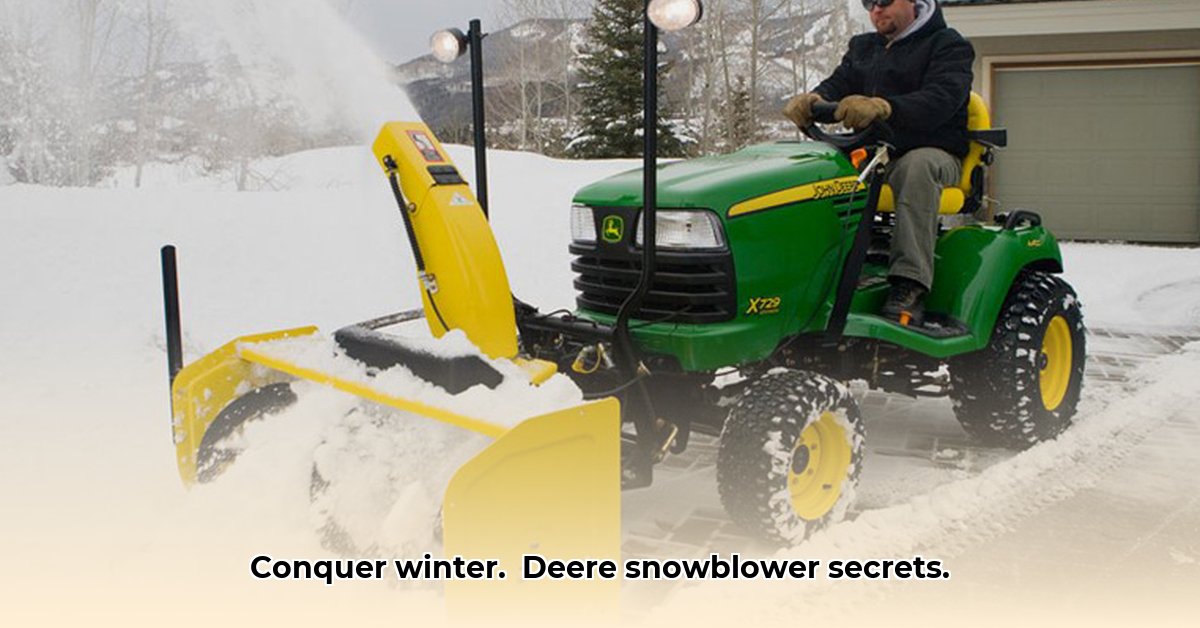
Assessing Your Snow Removal Needs: A Farm-Specific Approach
Before investing in a John Deere tractor and snowblower attachment, thoroughly assess your farm's unique needs. Factors like acreage, terrain complexity, typical snowfall, and budget significantly influence your equipment choices. Don't underestimate the importance of this initial evaluation; it directly impacts both efficiency and long-term cost-effectiveness. Will a wider snowblower justify the added power requirement of a larger tractor, or will a smaller, more maneuverable setup suffice? How much snow accumulation do you typically experience, and how frequently? Careful consideration will prevent costly mistakes. For younger farmers, consider electric options.
Choosing the Right John Deere Tractor and Snowblower Attachment
Selecting the right John Deere tractor and snowblower requires careful consideration of compatibility and performance. Not all John Deere tractors are created equal when it comes to snowblower attachments. Check the manufacturer's specifications to ensure compatibility with your chosen model. The snowblower's width should align with your acreage and typical snowfall; a wider blower clears more per pass but demands a more powerful tractor. Features like auger speed control and chute rotation enhance efficiency and control. A crucial factor often overlooked is safety: prioritize models with safety features such as shear pins and PTO (Power Take-Off) protection. Regular maintenance is essential for peak performance and longevity, minimizing downtime.
Installation and Operation: A Step-by-Step Guide
Attaching and operating your snowblower requires precision and adherence to the manufacturer's instructions. Safety is paramount. Always engage the parking brake before installation. Carefully connect the snowblower’s drive shaft to the tractor’s PTO shaft, ensuring a secure and correct connection. Secure all linkages and hydraulic connections, meticulously following the manufacturer's guidelines. Finally, lower the snowblower, ensuring proper alignment to prevent damage or uneven snow clearing. Begin operation slowly, gradually increasing auger speed. Adjust the chute direction to divert snow away from obstacles. Vary your speed based on snow depth and conditions; avoid overworking the engine. Never overload the snowblower beyond its capacity.
Maintenance and Storage: Protecting Your Investment
Consistent maintenance is crucial for extending the life of your equipment. Clean both the tractor and snowblower thoroughly after each use to remove snow and ice, preventing corrosion. Regularly inspect for wear and tear, lubricating moving parts as needed. Before long-term storage, follow John Deere's winterization guidelines, which may involve draining fluids and protecting metal components. Store your equipment in a dry, secure location, preventing premature wear. Proper storage and maintenance can dramatically increase the lifespan of your investment, reducing replacement costs and maximizing long-term value.
Financial Considerations and Long-Term ROI: Analyzing Cost Savings
While a precise return on investment (ROI) requires detailed financial projections, the long-term benefits of a John Deere tractor snowblower setup are significant. Reduced labor costs from handling snow removal in-house, minimized downtime by maintaining farm operations throughout winter, and increased efficiency by maximizing tractor utilization are all major advantages. However, consider the high initial investment, ongoing maintenance expenses, and the potential for equipment damage. While a precise ROI calculation may require specific cost figures, we should stress the importance of viewing winterization not as a purely financial expense, but as a strategic investment in the farm's long-term productivity and profitability. Exploring financing options can further mitigate upfront costs. What's the financial value of avoiding a costly equipment failure, or maintaining consistent farm productivity for an entire year?
Environmental Impact: Sustainable Winter Operations
While more research is needed to quantify the environmental impact precisely, using a John Deere tractor with a snowblower potentially offers environmental benefits compared to larger commercial snow removal vehicles. The reduced number of trips, smaller engine size, and potential for better fuel efficiency could contribute to a lower carbon footprint. This aligns with sustainable agriculture practices, promoting efficient resource usage and minimizing environmental impact. What role does minimizing fuel consumption and reducing emissions play in your overall sustainability goals?